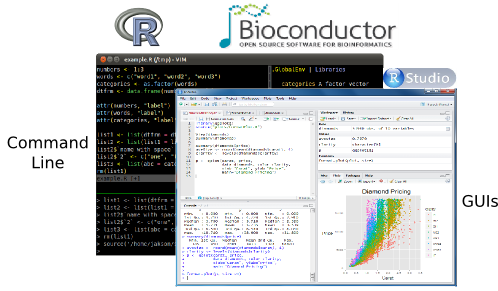Author: Thomas Girke
Last update: 23 August, 2017
Alternative formats of this vignette: [ HTML ], [ PDF ], [ .Rmd ], [ R ], [ Old PDF Slides ]
What is R?
R is a powerful statistical environment and programming language for the analysis and visualization of data. The associated Bioconductor and CRAN package repositories provide many additional R packages for statistical data analysis for a wide array of research areas. The R software is free and runs on all common operating systems.
Why Using R?
- Complete statistical environment and programming language
- Efficient functions and data structures for data analysis
- Powerful graphics
- Access to fast growing number of analysis packages
- Most widely used language in bioinformatics
- Is standard for data mining and biostatistical analysis
- Technical advantages: free, open-source, available for all OSs
Books and Documentation
- simpleR - Using R for Introductory Statistics (John Verzani, 2004) - URL
- Bioinformatics and Computational Biology Solutions Using R and Bioconductor (Gentleman et al., 2005) - URL
- More on this see “Finding Help” section in UCR Manual - URL
R Working Environments

Some R working environments with support for syntax highlighting and utilities to send code to the R console:
- RStudio: excellent choice for beginners (Cheat Sheet)
- Basic R code editors provided by Rguis
- gedit, Rgedit, RKWard, Eclipse, Tinn-R, Notepad++, NppToR
- Vim-R-Tmux: R working environment based on vim and tmux
- Emacs (ESS add-on package)
Example: RStudio
New integrated development environment (IDE) for R. Highly functional for both beginners and advanced.

Some userful shortcuts: Ctrl+Enter (send code), Ctrl+Shift+C (comment/uncomment), Ctrl+1/2 (switch window focus)
Example: Vim-R-Tmux
Terminal-based Working Environment for R: Vim-R-Tmux

 Previous Page Next Page
Previous Page Next Page
